Reports on Club Meetings (2023-2024)
To see reports of meetings held from 2012 to 8 May 2023 please.... click here
|
________________________________________________________________________________________________
Meeting held on 8th December 2025
Members with "Christmas Event"
A good time was had by all. The quiz winner was Trevor.
-300w.jpg)
*******************************************************************************************
Meeting held on 10th November 2025
Members with "Four Sheets from Everyone"
(Report and images to follow)
$$$$$$$$$$$$$$$$$$$$$$$$$$$$$$$$$$$$$$$$$$$$$$$$$$$$$$$$$$$$$$$$$$$$$$$$$$$$
Meeting held on 27th October 2025
Robin Cassell with "Mulready Caricatures and Pictorial Envelopes"
(Report to follow)
********************************************************************
Meeting held on 13th October 2025
8 in 3 -Islands - Members
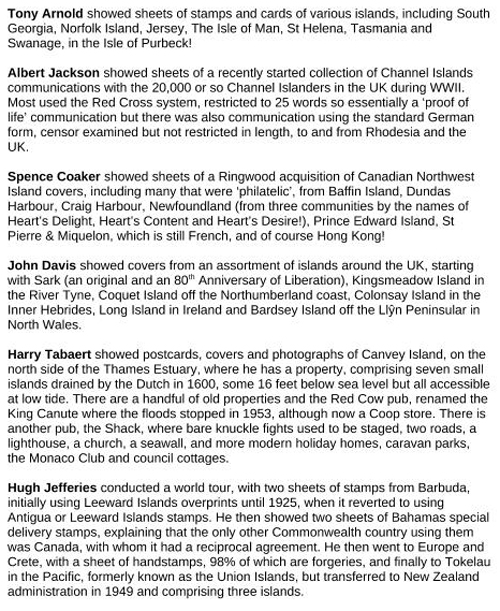
(Paul Barry)
@@@@@@@@@@@@@@@@@@@@@@@@@@@@@@@@@@@@@@@@@@@@@@@
Meeting held on 22nd September 2025
Salisbury visit us
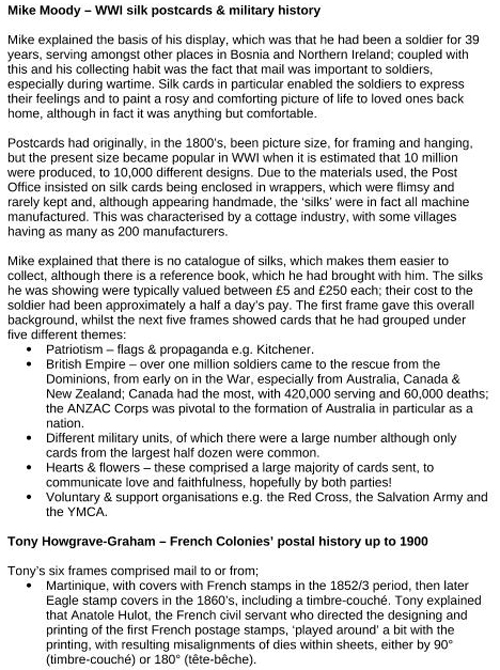
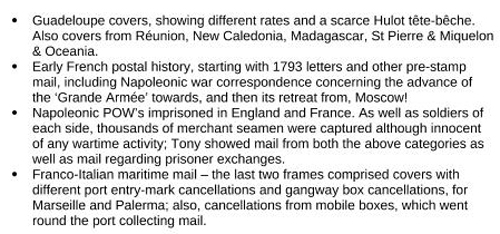
(Alan King)
*****************************************************************************************
Meeting held on 11th August 2025
Members - 8 in 3 Postal History and Covers
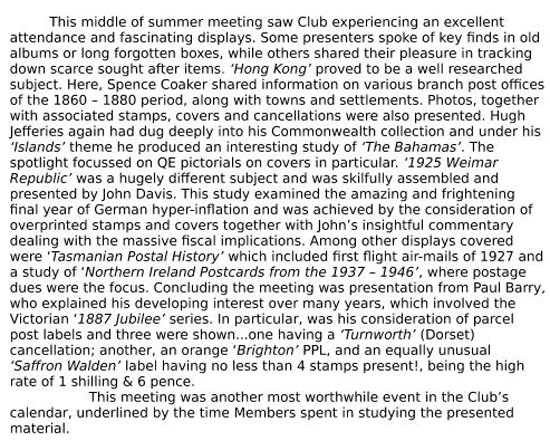
-11Aug2025-450w.jpg)
(Paul Barry)
*********************************************************************************************
Meeting held on 28th July 2025
Belgian Congo - Gerald Marriner FRPSL
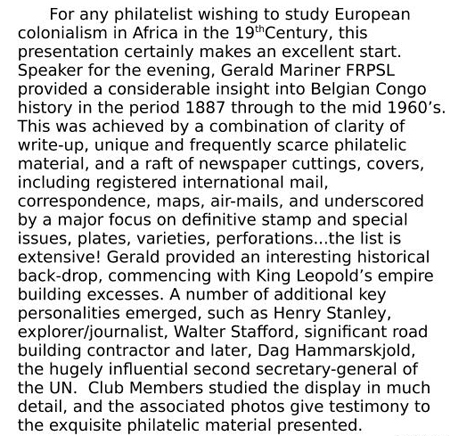
(Paul Barry)
***********************************************************************************************
Meeting held on 14th July 2025
Members - 12 in 5 Postcard Evening
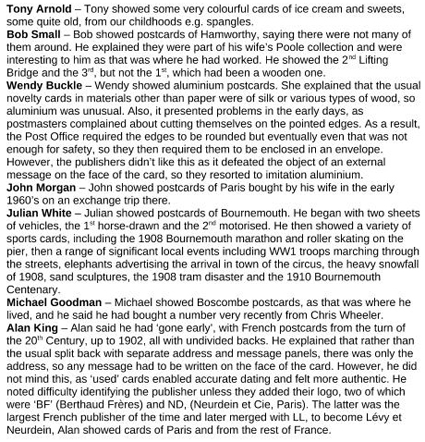
(Alan King)
+++++++++++++++++++++++++++++++++++++++++++++++++++++++++++++++++++++++++++++++++++
Meeting held on 23rd June 2025
Adrian de Bourbon - "British South Africa Company"
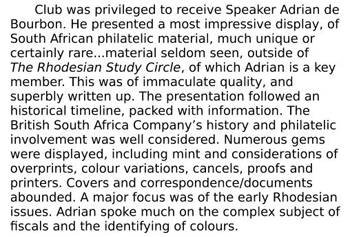
-600w.jpg)
(Paul Barry)
++++++++++++++++++++++++++++++++++++++++++++++++++++++++++++++++++++++++++
Meeting held on 9th June 2025
Members - 8 in 3 - Anything European
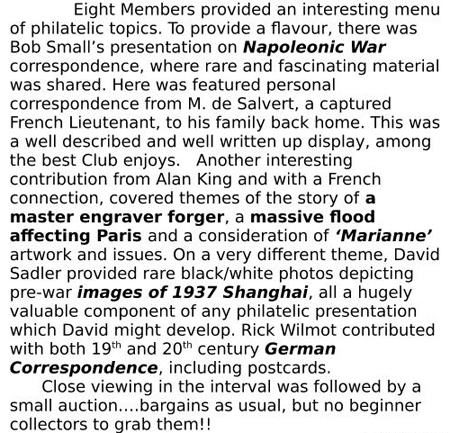
(Paul Barry)
*************************************************************************************
Meeting held on 26th May 2025
"Peace" - Grace Davies FRPSL
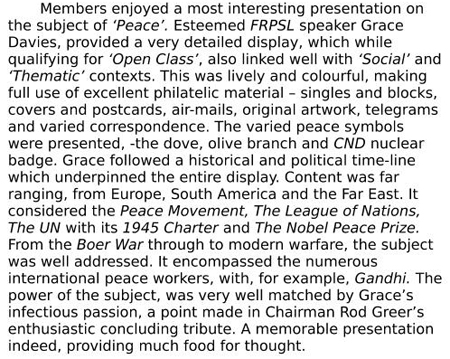
(Paul Barry)
*************************************************************************
Meeting held on 28th April 2025
"Aspects of Malaya" - Len Stanway FRPSL
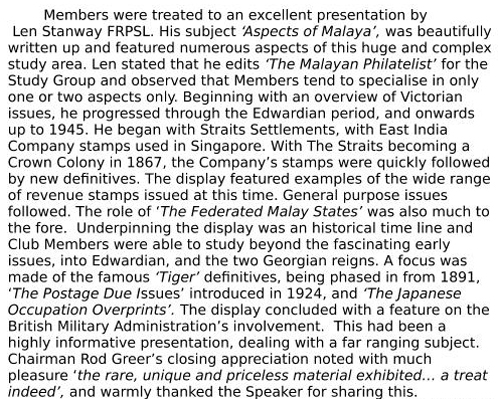
-200w.jpg)
(Paul Barry)
**********************************************************************
Meeting held on 31st March 2025
"US Classics" - Michael Goodman FRPSL
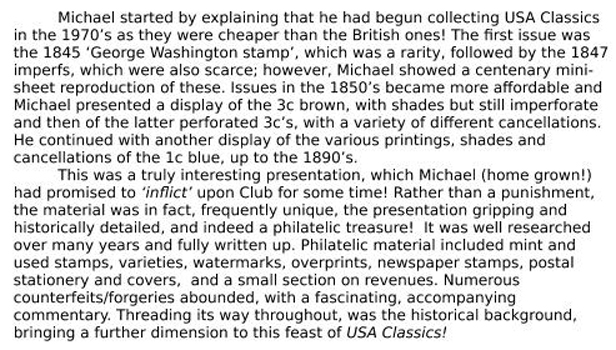
(Paul Barry)
%%%%%%%%%%%%%%%%%%%%%%%%%%%%%%%%%%%%%%%%%%%%%%%%%%%%%%%%%%%%
Meeting held on 10th March 2025
Members: Annual competition, including one sheet competition
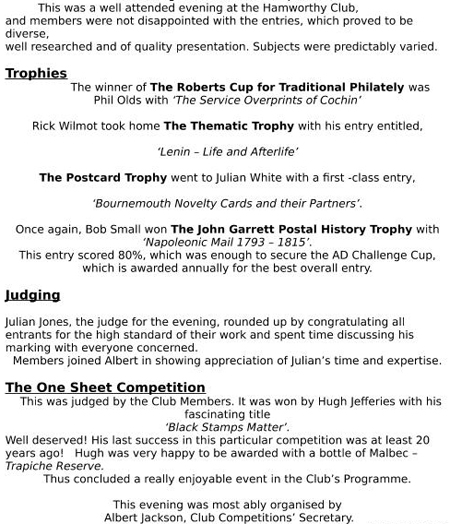
(Paul Barry)
%%%%%%%%%%%%%%%%%%%%%%%%%%%%%%%%%%%%%%%%%%%%%%%%%%%%%%%%%%%%
Meeting held on 24th February 2025
"British Levant and Forces in Egypt" - Julian Bagwell
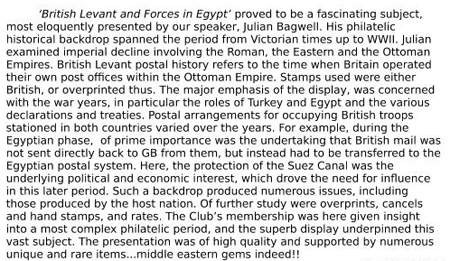
(Paul Barry)
&&&&&&&&&&&&&&&&&&&&&&&&&&&&&&&&&&&&&&&&&&&&&&&&&&&&&&&&&&&&&&&
Meeting held on 10th February 2025
"8 in 3 - ...and my theme is ..." - Members
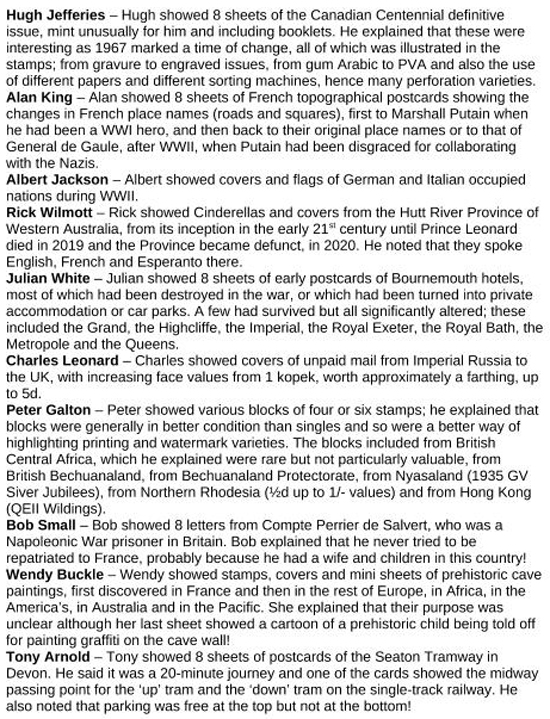
-400w.jpg)
(Alan King)
*****************************************************************************
Meeting held on 27th January 2025
"12 in 5 - Free Choice" - Members
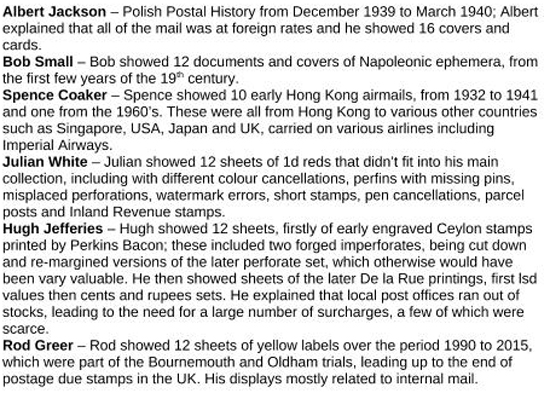
-350w.jpg) |
-350w.jpg) |
| |
Forces Mail, China to Southampton, 1938 |
-370w.jpg) |
-350w.jpg) |
| Printed Revenue Collection Labels |
|
-350w.jpg) |
-419w.jpg) |
| |
Misplaced Perforations |
(Paul Barry and Alan King)
*****************************************************************************
Meeting held on 13th January 2025
"Competition Workshop" - Wendy Buckle, Albert Jackson and Colin Mount
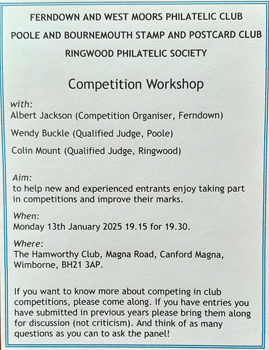
**********************************************************************************
Meeting held on 25th November 2024
"Turkey" - Albert Kemp
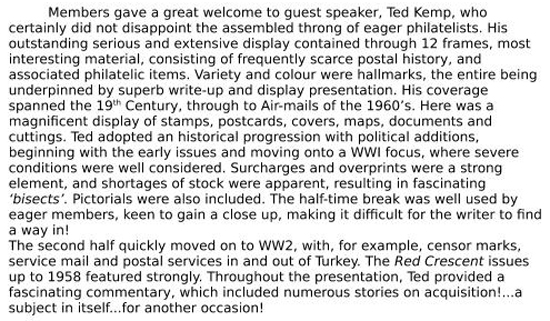
-200h.jpg)
(Paul Barry)
************************************!!!!!!!!!!!!!!!!!!!!!!!*************************************
Meeting held on 11th November 2024
"Four Sheets from Everybody" - Members
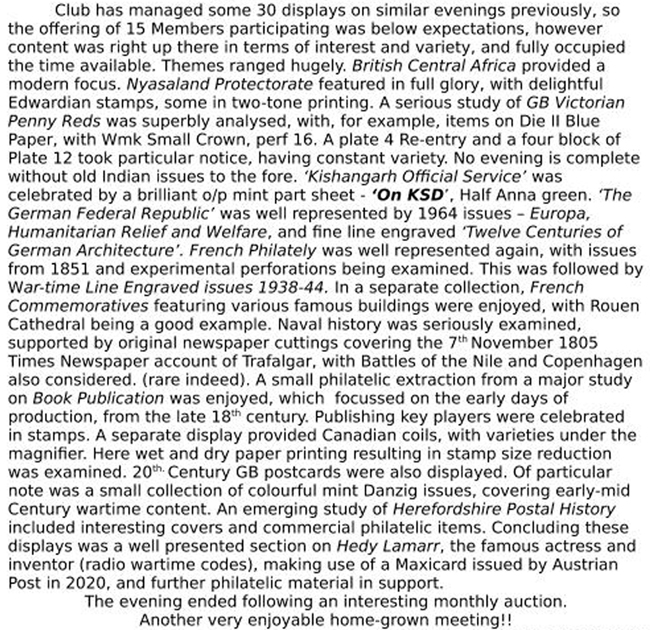
-11-Nov24-600w.jpg)
(Paul Barry)
$$$$$$$$$$$$$$$$$$$$$$$$$$$$$$$$$$$$$$$$$$$$$$$$$$$$$$$$$$$$$$$$$$$$$$$$$$$$$$$$$$$$$$$
Meeting held on 28th October 2024
"The Dream of Konstantin Tsiolkovsky" - Rick Wilmot
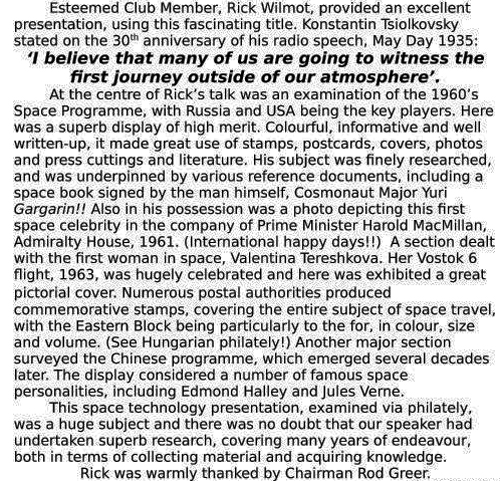
-550w.jpg)
-600w.jpg)
-315w.jpg)
(Paul Barry)
%%%%%%%%%%%%%%%%%%%%%%%%%%%%%%%%%%%%%%%%%%%%%%%%%%%%%%%%%%%%%
Meeting held on 14th October 2024
"Definitely Definitive (stamps or covers)" - Members
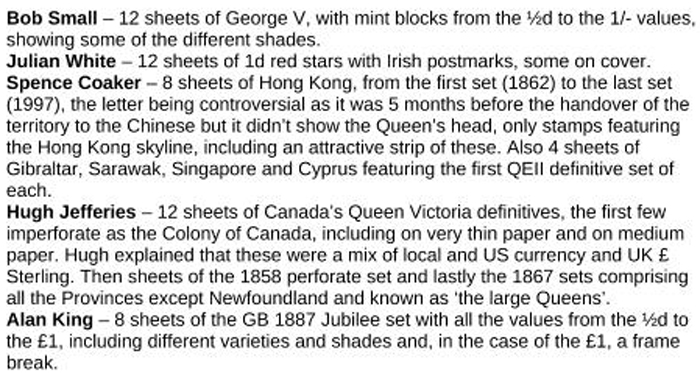
(Paul Barry and Alan King)
$$$$$$$$$$$$$$$$$$$$$$$$$$$$$$$$$$$$$$$$$$$$$$$$$$$$$$$$$$$$$$$$$$$$$$$$$$$$$$$$$$$$$$$$$$$$$$
Meeting held on 23rd September 2024
"For safe Conveyance" registered mail in the UK to 1907 - Maurice Buxton FRPSL
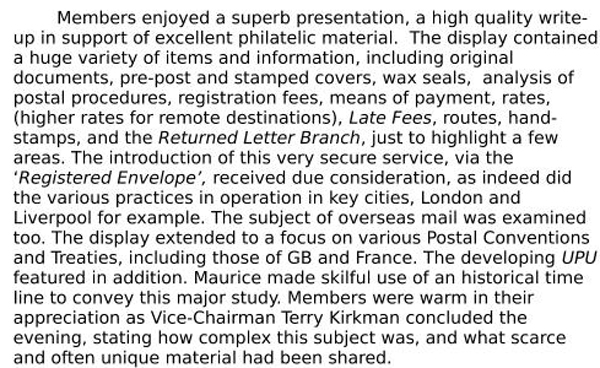
-500w.jpg)
(Paul Barry)
***********************************************************************************************
Meeting held on 9th September 2024
"My Theme Is ..." - Members
-600w.jpg)
(Paul Barry)
**********************************************************************************************
Meeting held on 12th August 2024
"8 in 3 Members Displays" - Members
Considering this was the middle of August meeting, it was particularly pleasing to see some 20 Members attend; clearly worth still holding this summer event.
There were six displays and each quite distinctive.
Rick Wilmot batted first with an interesting collection of early Victorian GB covers. One of note was a Dublin postmarked cover of ‘MR 16 75’ with scarce ‘INSUFFICIENT PREPAID’ strike.
Spence Coaker again delved into his fine Hong Kong resource. An interesting map of the numerous islands set the scene. A very fine cover depicting the Centenary set was colourful indeed. This was dated 23rd June 1941 Cheung Chau to Wellington, NZ. This presentation covered in some detail the various postmarks in use over many years -a fine study. Terry Kirkman followed with a worthy set of KGVI Australian covers.
Bob Small is never far from his extensive French history interest. Here Members were given a glimpse of French intentions to invade England!! Timing...towards the end of the 18th Century. 5 covers were seen, together with artists’ impressions of invasion machines; a huge raft for moving scores of military and a fascinating massive balloon, with similar purpose!! (‘The Decent to England -The Montgolfiere Project).
Paul Barry shared further examples from his Herefordshire inspired Victorian covers and a special later acquisition, a Shaftesbury Penny Post red stamped Penny Black entire, addressed to Downton, Wiltshire.
Hugh Jefferies is most adept at diving into his vast and varied collection, and no exception this time. Here was a consideration of GB ‘Postage Due Mail’ from the early decimal period. He described the changing regulations pertaining to charging customers over a 16 year period. 1983 PRAMA Labels were also featured. It would appear that Hugh has been held in some amazement by London Post Office counter officials, being perhaps their only client ever to demand to pay his postage due fee!!! (ask Hugh for the details!!)
The evening concluded with a small auction, where some sound bargains were available, including a number of SG part filled albums managed by Alan King who has been long involved in visiting owners and processing their collections.
.jpg) |
-300w.jpg) |
-350w.jpg) |
-350w.jpg) |
-400w.jpg) |
Paul Barry Publicity
^^^^^^^^^^^^^^^^^^^^^^^^^^^^^^^^^^^^^^^^^^^^^^^^^^^^^^^^^^^^^^^^^^^^^^
Meeting held on 22nd July 2024
"The Committee Presents" - 4 x 3 Frames
(Alan King)
%%%%%%%%%%%%%%%%%%%%%%%%%%%%%%%%%%%%%%%%%%%%%%
Meeting held on 8th July 2024
"8 in 5 - GB and Channel Islands only" - Members
(Alan King)
%%%%%%%%%%%%%%%%%%%%%%%%%%%%%%%%%%%%%%%%%%%%%%%%%%%%%%%%%%
Meeting held on 24th June 2024
"Gibraltar Postal History" - Eric Holmes
(Alan King)
%%%%%%%%%%%%%%%%%%%%%%%%%%%%%%%%%%%%%%%%%%%%%%%%%%%%%%%%%%
Meeting held on 10th June 2024
"8 in 3 - Postcards" Members
The collecting of postcards may seem a minority sport in some philatelic associations, but this Club has always made good provision within the programme. Postcards continue to feature strongly in presentations across the year, and a designated evening certainly sees good participation both in displays and in Member interest. This evening proved to be no exception, with a fair range of subjects considered. ‘The Theatre’, followed by 8 interesting colour frames on ‘D-Day’ began proceedings. A later display covered this same topic and produced a fascinating card postmarked 7 June, 1944, written by a German soldier. Here the writer provided an interesting comment on places of landings! A worthy study of Paris based publishing featured, linked to the latter part of 19th Century (‘LL’ Publisher’s trademark). The emergence of very fine reproduction was in evidence within the display. Black/white or sepia, with a few hand coloured cards were present. Views and street scenes predominated and the presence of quite detailed information on reverse was noted. Fascinating collections of mainly old local cards were presented, covering such locations as Christchurch, Iford, the Ferry, Tuckton and the Bridge, New Forest and Cadnam, followed by ‘then and now’ Bournemouth Hotels. Within this, was depicted the Metropole Hotel, later bombed! No postcard evening is complete without the colourful ‘Seaside Humour’ input!!, and here our presenter provided no commentary, except to state he had nothing to say as... ‘these cards speak for themselves!’ Taking a ‘Wessex’ theme, pleasing cards were presented with a main consideration of Thomas Hardy. This display was very well supported by an engaging commentary, providing much insight; a fine conclusion to an excellent ‘home-grown’ evening.
(Paul Barry)
%%%%%%%%%%%%%%%%%%%%%%%%%%%%%%%%%%%%%%%%%%%%%%%%%%%%%%%%%%
Meeting held on 27th May 2024
"Finland Maritime Mails" by Charles Leonard
This was clearly a magnificent display of frequently scarce material, all underpinned by variety and high quality presentation and write-up. When asked what had originally prompted his focus on this philatelic area, Charles replied that he had become interested in Russian stamps – ‘their colour!!‘ This gradually led to his study of Finland in tandem with the build up of his collection. Chairman Rod Greer in his vote of thanks, first drew breath, then stated -‘a fantastic collection’. Tracing his subject from early times, Charles made mention of the fact that in 1638 Finland was part of the Swedish Empire! Following an historical time-line, Members were given much insight into the development of Finland’s economy and the associated trading arrangements. By the late 19th Century, major shipping lines were established, the ‘Steamship Era’ being the major focus. The presentation covered maps and routes, ships and the establishment of mobile on-board Post Offices. Initially timber and butter were major trading players, but quickly developed into a significant and varied market, Interesting cancellations featured and consideration was given to both commercial and personal mails, both in and out-bound. Very early covers, postcards and photos all contributed, as did a number of artistic items, including the suberb advertising poster illustrated here. A wide range of stamp issues were present including a modern mini-sheet..the subject’s scope being wide and full of interest.
Home-grown presentations do take some beating!!
-27May2024-250w.jpg) |
-27May2024-245w.jpg) |
-27May2024-300w.jpg) |
-27May2024-300w.jpg) |
(Paul Barry)
%%%%%%%%%%%%%%%%%%%%%%%%%%%%%%%%%%%%%%%%%%%%%%%%%%%%%%%%%%
Meeting held on 22nd April 2024
"The Bailiwick of Guernsey" by David Winnie FRPSL
22April2024-650w.jpg)
(Paul Barry)
$$$$$$$$$$$$$$$$$$$$$$$$$$$$$$$$$$$$$$$$$$$$$$$$$$$$$$$$$$$$$$$$$$$$$$$$$$$$$$$$$$$$$$$$$$$$$$$
Meeting held on 8th April 2024
"12 in 5", the Choice is Yours - Members
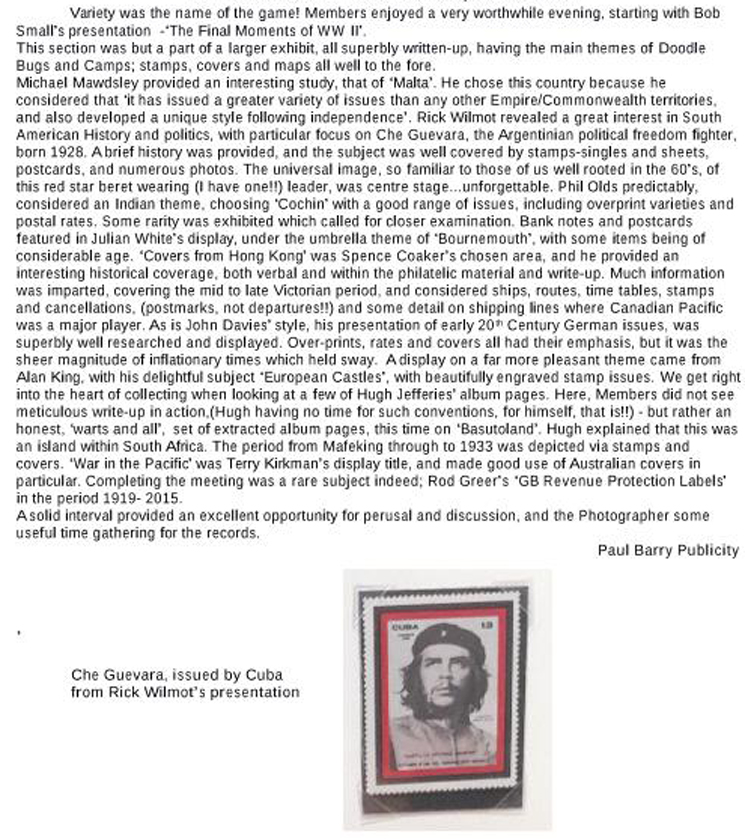
**************************************************************************************************
Meeting held on 25th March 2024
"Hungarian Stamp Designs of Sandor Legrady" - Brian Snape
-Text-725w.jpg)
(Paul Barry, Publicity)
^^^^^^^^^^^^^^^^^^^^^^^^^^^^^^^^^^^^^^^^^^^^^^^^^^^^^^^^^^^^^^^^^^^^^^^^^^^^^^^
Meeting held on 11th March 2024
Annual Competitions, including One Sheet Competition
The Hamworthy Club provided an excellent venue for this major philatelic event. The main focus continues to be the single frame 16 sheet competition, judged this year by Wendy Buckle and Colin Mount, who were impressed not only by the overall quality present, but also with the variety of entries.
Trophies were awarded to the following participants:-
- John Davis for the Traditional/Generalcategory.
- Bob Small for Postal History.
- Julian White for Postcards.
- Rick Wilmot for Social Philately.
- The Arthur Denyer Trophy for highest points overall - presented to Bob Small.
While the judges went to work, the One-Page Competition was in progress. Here, members were asked to vote for their favourite entry, which this year was provided by Wendy Buckle. Sincere thanks were given to all members who took the trouble to enter and, more especially, to the two judges who went to great lengths, not only in examining the entries with care and attention, but also for staying behind to discuss their conclusions with the entrants. This most successful Annual Competition evening was further enhanced by a general knowledge quiz and auction organised by members of the Club Committee...all very much appreciated.
 |
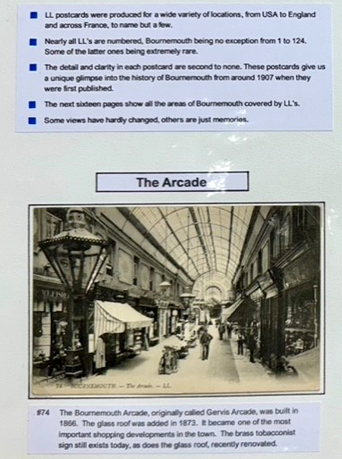 |
| From John's display |
From Julian's display |
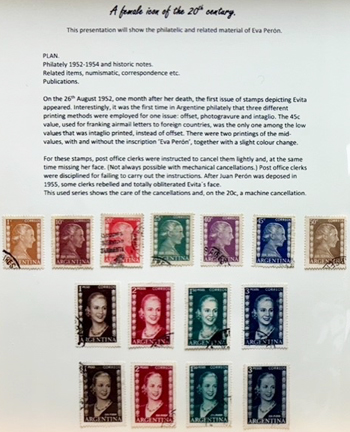 |
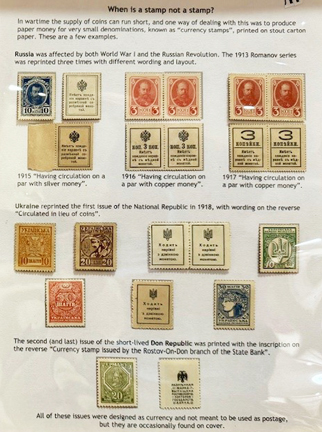 |
| From Rick's display |
From Wendy's display |
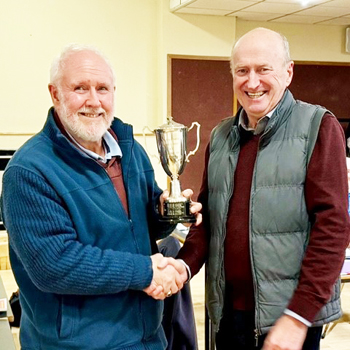 |
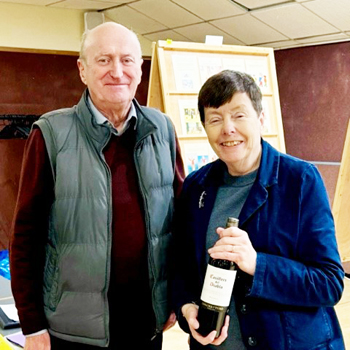 |
| Bob with "Best in Show" Trophy |
Wendy with reward for winning single sheet |
(Albert Jackson, Competitions Officer)
****************************************************************************
Meeting held on 26th February 2024
“Irish Postal History up to and including Partition”
by Stan Challis FRPS
Rod Greer introduced Stan by saying that he was president of the Irish Philatelic Society and had been its journal editor for 12 years. Stan added that he had recently finished writing his book "Irish Diamonds” on Irish postal history from 1840, which had taken him 30 years to complete!
Stan showed some pre-mail covers from 1704, then Mulreadys, then 1840 onwards covers, first with Maltese crosses then the “1844-type” cancellations, explaining that whereas in England these were oval, in Ireland they were diamond shaped. The covers featured examples from different offices and towns throughout Ireland and the cancellations were in both black and blue and, in a few rare cases, green.
He then showed some “spoon” cancellations, explaining that they had different numbers from the English spoons. However, the numbering was confusing as it was not sequential.
The first three frames covered the Victorian period, the 4th a collection of mail to one particular person in New South Wales, sent by a number of different routes, the 5th mail from Queenstown, a port and naval base six miles outside Cork and the 6th registered mail from 1841 to Partition, 1922, again sent by different routes.
In the second part of his talk, Stan showed, in the 1st frame, the beginning of the Irish overprints of English stamps in February 1922, explaining that it had been a “rush job” due to the late arrival of the black ink required. The process was interrupted by the Irish civil war in June, leading to blue ink replacing the black, first for the provisional government overprints and then for those of the Irish Free State. British stamps continued to be valid for a while and, for the higher values, right up until 1937.
In the 2nd frame he showed a selection of slogan postmarks from the 340 issued, in the 3rd overseas mail into and out of Ireland, in the 4th TPO’s including a unique cover from 1825 of the Limerick mail coach, in the 5th express mail and in the 6th postage dues.
Rod Greer thanked Stan Challis for an impressive collection of material covering a time when the post office in Ireland had been destroyed and many of the records lost and presented him with a certificate and engraved tumbler.
-465w.jpg) |
| A Registered Green Envelope |
.jpg) |
%%%%%%%%%%%%%%%%%%%%%%%%%%%%%%%%%%%%%%%%%%
Meeting held on 12th February 2024
“12 in 5 – Australasia and Pacific”
Terry Kirkman showed an eclectic variety of Australian Cinderella’s and covers, comprising commemorative labels, tax stamps, flight and other covers. Rick Wilmot showed stamps from the Cocos and Keeling Islands. He explained that the Islands were owned by Australia despite being some 4,000 kms away. He said their stamps were very pretty but not very valuable; he showed amongst other things local flora and fauna and also the life cycle of the coconut! He then showed a large tableau with the colourful history of the Islands, which he went on to recount:-
Although discovered by Captain Keeling in 1609, they were not inhabited until 1825 by a Scottish trader, Captain Ross, who stopped briefly on his way to India, nailing up a Union Jack and planning to return and settle with his family. However, before he could achieve this, a wealthy Englishman, Alexander Hare, had similar plans and hired Ross's brother to bring him a volunteer harem of 40 Malay women to the Islands, where he hoped to establish his private residence.
Ross returned two years later with his wife, children and mother-in-law to find Hare already established on the Islands and living with the private harem. A feud grew between the two. After some time, Hare's women began deserting him, instead finding themselves partners amongst Ross's sailors. Disheartened, Hare left the Islands and died soon afterwards. Ross then recruited further Malays to come to the Islands for work. Today, some 600 inhabit the Islands, mostly Cocos Malays.
Both Hugh Jefferies and Alan King gave almost identical displays (the first time it’s happened!) of the Kangaroo series from Australia, that ran through five watermarks and many colour changes, from 1913 to 1931. Both collections had been built up over many years and Hugh gave interesting stories of how he had acquired some of his better items, including one of the high value Kangaroos from Stanley Gibbons, where they had failed to identify an inverted watermark – he didn’t tell them! Alan said he had examples of every stamp except the top value 1st watermark £2 black and rose.
.jpg)
Alan King
*******************************************************************************
Meeting held on 22nd January 2024
"Mind your Ps and Qs" - Barry Hobbs
The title of the display created some puzzlement among the assembled members and it came as something of a surprise when Barry explained that the letters stood for Pills, Potions and Quackery – a history of Quack Medicine in the USA as told through illustrated covers sent during the golden age of such advertising from the 1850s up to the end of the First World War.
Until the passing of the food and Drug Act in 1906, there was no restriction whatsoever on whom could set up as a drug manufacturer. Some people were genuine and wanted to improve the lot of their fellow men and women. However, many were often charlatans whose only interest was in making vast amounts of money. The claims made for the preparations were often inflated and dishonest and Barry illustrated this point by referring to medicines claiming permanent cures for cancer, consumption and Spanish flu. The contents of these medications could be nothing more than placebos. At the other end of the spectrum some were positively dangerous and addictive. They could do serious harm and in extreme cases prove fatal if taken in sufficient quantities. A common ingredient in many potions was alcohol – considerable quantities of it - that ensured that if nothing else, the patient felt some relief from the symptoms of the disease!
In the first half of the evening, Barry talked of the symbiotic relationship that existed between the medicine industry and the American Post Office, as many manufacturers conducted much of their business by mail order. A symbiotic relationship also existed between the medicine companies and the newspaper industry. Heavy advertising was essential for success and newspapers depended on the revenues generated for their survival. This mutual dependence did much to prevent editors and reporters from campaigning for laws to regulate medicines.
In the second half, Barry displayed covers advertising bandages, supports and artificial limbs. Veterinary medicines also featured as people often used them for human complaints – two spoonfuls for the horse and one for the human! Barry rounded off the evening by placing the illustrated envelopes in the wider context of advertising in general, displaying trade cards, revenue and encased stamps, testimonial booklets and songsters used in medicine shows.
-475w.jpg)
-450w.jpg)
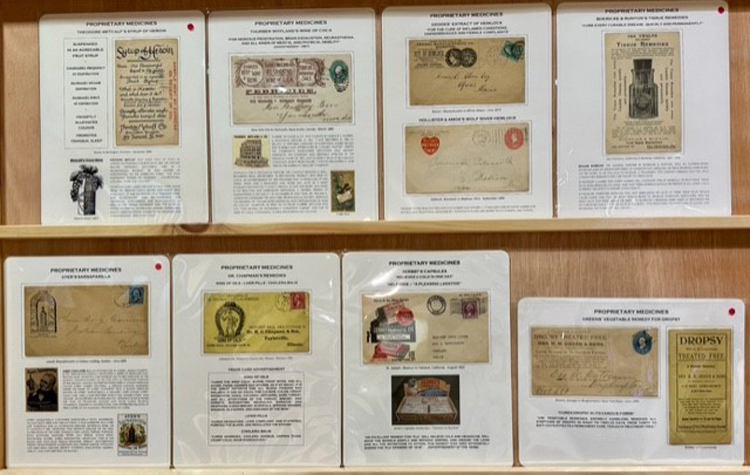

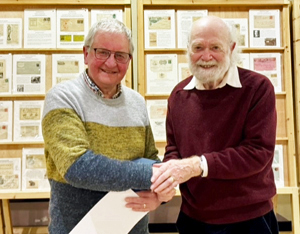 |
| Barry Hobbs receiving his Certificate |
(Barry Hobbs)
^^^^^^^^^^^^^^^^^^^^^^^^^^^^^^^^^^^^^^^^^^^^^^^^^^^^^^^^^^^^^^^^^^^^^^^^^^^
Meeting held on 8th January 2024
"8 in 3 with the letters E or F" - Members
An excellent attendance, together with mini displays in the theme ‘E’ and ‘F’ from ten Members, made sure the new programme year started well, despite subs being required!!
The presentations were based mainly on album pages, with a few being extracts from formal written-up studies used in competition. Subjects were diverse, from finely designed French issues within the theme ‘People’ (1935-60), to a sharply considered display -’Polish Mail from WW2’, to, for example, ‘Cross Border Mail from the Irish Free State’; a wide range of postcards, including historical interest both local and further afield, with a study of ‘The Falmouth Packet Agency -1810’.
A further selection was presented, being that of ‘GB Victorian Jubilee Stamps’, appearing on covers, advertising mail, colour-printed cards, a Certificate of Posting and a superb cover to Tourcoing, NE France, posted into the Late Fee Box at Cannon Street, depicting fine strikes of the duplex Continental Overnight Mail and transit hand-stamp of the Paris to LilleTPO. Additional interest was present with examples of Falklands and Egyptian stamps, and a consideration of ‘The US One Cent Blues and their usage’.
An excellent start to a philatelic year, packed with goodies!!
Paul Barry Publicity
***************************************************************************************************
Meeting held on 11th December 2023
Christmas Meeting
Club Members gathered in good numbers for this Christmas Meeting, encouraged no doubt, by free bar drinks, excellent Raffle and quizzes! Terry Kirkman provided his usual challenging general knowledge quiz, with Hugh Jefferies in support, providing a fully philatelic test, covering world issues. As Programme Secretary, he was pleased to share his hot off the press, 2024 programme of planned Meetings. It was clear that much effort had been expended, enabling a truly magnificent set of events for the membership, which incidentally, is still growing!
Thanks go to Hugh, Terry and indeed Alan King who made the arrangements for this, the final meeting of 2023.
Join us in January (8th) for:- 8 in 3 ‘E’ or ‘F’ + Members’ Auction
The image shows Hugh Jefferies reporting on the quiz results |
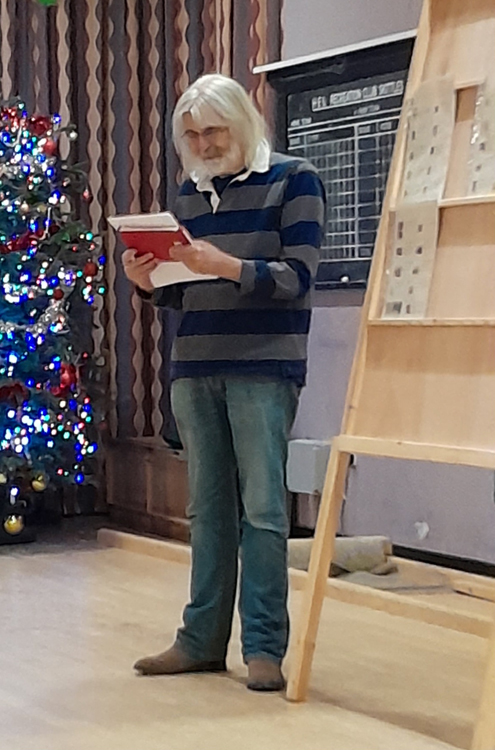 |
( PAUL BARRY PUBLICITY )
^^^^^^^^^^^^^^^^^^^^^^^^^^^^^^^^^^^^^^^^^^^^^^^^^^^^^^^^^^^^^^^^^^^^^^^^^
Meeting held on 27th November 2023
Wendy Buckle FRPSL with
‘6000 Years of Writing Materials’
Members were certainly well entertained to a highly specialised feast, underpinned by huge research and quality presentation and by philatelic study and inclusion. Speaker and Club Member, Wendy Buckle FRPSL described her amazing resource as ‘a light hearted look at various cultures in their use of writing materials, of which 21 different materials are shown’. Under the title ‘Animal, Vegetable and Mineral’, the scope of this superb presentation was extensive. Touching first on the familiar, Wendy identified the Egyptian and Roman use of stone as a writing material, seen for example, in memorials and tombstones. Metal was considered, being a material used by rich rulers to impress. There was the example of metal (aluminium) postcards, not Post Office friendly, until receiving rounded edges and envelope covering! Moving on to wood, this material, widely used in Scandinavia and Russia, was followed by the use of cork, being a product of Portugal and Spain. Birch bark from Sweden was also featured within the display. The Chinese made much use of the mulberry tree to manufacture paper, as was their widespread use of bamboo, both as a writing material and for paper. From the Far East, there was the use of palm leaves, with, from Egypt, the widespread use of papyrus was seen, which will last for hundreds of years in the right conditions. The silver tree, from Table Mountain, was well used, particularly in Edwardian times, almost to extinction. Of great rarity was observed the Mutton Bird shrub’s paper manufacture from New Zealand. Peat and flax from Ireland were featured. Cotton was used originally in paper manufacture, a product particularly appreciated by artists in search of quality. Wendy provided sheets devoted to the use of bone, leather, vellum, parchment and silk, where her embroidered cards were quite exquisite. Paper was highlighted as a front runner, emerging as a worldwide product attracting governmental taxation!
Following much inspection and debate in the interval, Wendy then provided a most interesting study of John Dickenson’s emerging 19th century paper empire. This section made good use of stamps, covers, cards, photos and advertising examples, plus 3D items including lovely models of a railway wagon and commercial van. The development of Dickinson’s company was well covered, looking at the early 1800s with the machine made paper manufacture. The development of the Mulready and 1d and 2d postal stationery items were highlighted, but his inability to secure the Penny Black/Twopenny Blue contracts was noted. (monopoly issue) The emergence of Dickinson’s security papers featured, being of particular importance during the two World War periods. Further company products were considered.
An interesting section focussed on Rowland Hill’s huge postal innovations.
Vice Chairman Terry Kirkman, praised the sheer quality of research and materials displayed and voiced the appreciation of all.
He then presented Wendy with the Club’s Certificate and Engraved Glass Tumbler.
-250w.jpg) |
-500w.jpg) |
| Synthetic |
Viewing the Display |
-350w.jpg) |
-350w.jpg) |
-210w.jpg) |
| Croxley Paper Mills Railway Wagon |
Basildon Bond Delivery Van |
Thanks! |
(Paul Barry Publicity)
^^^^^^^^^^^^^^^^^^^^^^^^^^^^^^^^^^^^^^^^^^^^^^^^^^^^^^^^^^^^^^^^^^^^^^^^^^^^^^^^^^^
Meeting held on 13th November 2023
4 Sheets – Everyone, No Excuses!!
The Club enjoyed an excellent attendance with 23 persons present. No less than 17 presentations were received. Luckily, Programme Secretary Hugh Jefferies’ attention was well glued to the displays, and so the naughty bunch who failed to contribute, despite the ‘three-line-whip’, got away with it (this time!)
As usual, the range of subject was wide, with subjects ranging from Hugh’s ‘Postage Dues - 1930’s Australia’, to Alan King’s ‘Publicity on French Stamps’; from Albert Jackson’s ‘Danzig Corridor’ to, for example’, ‘The History of Painting’ - William Caxton’, by Wendy Buckle.
John Davies’ ‘Disinfected Mails’ was infectious!, as indeed (a different reason) was Spence Coaker’s ‘Hong Kong – The Centenary Issue of 1941’. Here was great artistry and colour at work; familiar stamps maybe, but nevertheless well included. Terry Kirkman as usual provided interest with his ‘4 Aspects of Philately’, which included his seasonal ‘Christmas Crackers’...joke section!! (yes, philately should be fun!!) Other subjects of equal merit were ‘Scuttling the Fleet at Scapa Flow’, ‘The Weirmar Republic’, ‘Bournemouth Postcards’, ‘PoW History’, including Colditz Escapee - Pat Reid (signed cover), Local History in old postcards, fascinating coverage of ‘Luna Exploration’ and ‘Northern Ireland’ philately, ‘Herefordshire via Postal History’, and finally Michael Goodman’s ‘Final Throws of Postal Goes’. (tears indeed!) Somehow Michael will recover, but it may take the Xmas break to achieve it!!
In the meanwhile...Seasons Greetings to one and all!!
-350w.jpg) |
-350w.jpg) |
| Advertising on French Stamps |
History of Printing - Caxton |
-700w.jpg)
Hong Kong Air Mail Cover - Centenary 1941
(Paul Barry Publicity)
**********************************************************************
Meeting held on 23rd October 2023
"Anschluss" - Albert Jackson
Albert began by explaining that the term Anschluss referred to the unification of Austria with Germany, just before WWII. The idea of an Anschluss began in the early 1920s, with the fall of the Austro-Hungarian empire after WWI. Austria needed financial support and saw the idea of a Deutschösterreich (German-Austria) movement as a solution. However, the Allies’ Treaty of Saint-Germain in 1920 forbade both the union and the continued use of the term Deutschösterreich. Albert went on to describe the turbulent politics that defined Austria throughout the 1930s, with left-wing and more conservative parties vying for power. Eventually, sentiment began to coalesce under Chancellor Engelbert Dollfuss and the Fatherland Front, a right-wing alliance that held power for five years from 1932.
Meanwhile, the Nazi party were gaining power in Germany and Hitler began to have aspirations to incorporate Austria, the country of his birth. In Austria, an extremist National Socialist Party tried to take power by force, mortally wounding Dollfuss who subsequently died from his injuries. Dollfuss‘ replacement, Kurt von Schuschnigg, attempted to make peace with Nazi Germany, but Hitler’s response was to threaten invasion unless radical changes to government were made in Austria. Under pressure, Schuschnigg resigned, but it was too late to deter Hitler. On 12 March 1938, the Germans invaded. In reality, the German army simply ‘walked’ into Vienna unopposed and were welcomed by cheering crowds. Hitler himself was driven to Vienna, giving triumphant speeches on route.
On his return to Germany, Hitler launched a campaign to annex Austria, calling for a referendum to legitimise his decision. Among other organisations, the post offices of Germany and Austria were instrumental in presenting propaganda to encourage people to vote: a special cancel “On 10 April say ‘yes’ for your Führer” was one such slogan. Propaganda cards were produced with the campaign slogan “Ein Volk, Ein Reich, Ein Führer”, as were leaflets, slogan cancellations, postal stationery and matchbox labels. Special election-day stamps, postal stationery and cancellations were also available. The result of the Anschluss referendum was a resounding ‘Yes’ and propaganda cards and postcards were issued celebrating victory. With Austria becoming a German province known as the Ostmark, all national events and festivals were commemorated with special postmarks and propaganda cards, culminating with “The First People’s Christmas in the Ostmark”.
Rod Greer thanked Albert for his amazing story and supporting material, saying that although most of us had a general idea of events, few of us knew all the details that Albert had so expertly displayed.
-250w.jpg) |
-250w.jpg) |
-250w.jpg) |
| Tyrolean plebiscite for Deutchösterreich |
Left-wing opposition to Dollfuss |
Nazis ridiculing Dollfuss (Punch cartoon) |
-250w.jpg) |
-250w.jpg) |
-250w.jpg) |
| Schuschnigg driven out of office |
German leaflet dropped on day of invasion |
Campaign slogan |
-250w.jpg) |
-250w.jpg) |
| Hitler's Birthday |
First Christmas in the Ostmark |
(Alan King and Albert Jackson)
*************************************************************************
Meeting held on 9th October 2023
8 in 3 "Covers and Postal History ONLY" - Members
Unusually, despite there being a good attendance, there were only three presentations. However these were of excellent quality and interest and were keenly viewed and discussed in the interval, which divided the evening, with a most successful auction. This produced a record surplus for the year, which was due in considerable part to the much appreciated auctioning of a significant range of kindly donated philatelic books. There are still more to be auctioned!
The subject ‘RASC Censored Mail’ was presented by Brian Quist and proved to be part of a significant study. Here was explained that throughout various wars, mail needed to be censored to ensure security of information. He showed examples of such censoring, from the Boer War onwards, including unusual covers and censor marks from the Red Cross and the Salvation Army.
‘Bournemouth Postal History’ was again a well researched presentation. Julian White showed early covers, including Tregonwell (one of the founders of the town) in 1824, from Bournemouth to USA, to South Africa, to Switzerland, to India and to Australia. Additionally fascinating covers were noted from Monte Carlo to Bournemouth, culminating with a rare Mulready, having a Bournemouth address.
‘Covers from Bahamas’ was the final study, being compiled by Hugh Jefferies who skilfully set the scene. He explained that the Bahamas were made up of a large number of islands, with numerous post offices, cancellation methods and styles. He showed covers from well described Long Island and Crooked Island, but the naming of Cat Island was a mystery, not being cat shaped!
Another most entertaining evening in a well packed philatelic programme.
(Alan King)
"""""""""""""""""""""""""""""""""""""""""""""""""""""""""""""
Meeting held on 25th September 2023
"Russia's International Mails/The Mail between Great Britain and Russia" Charles Leonard
Without doubt, this presentation was of top quality in all respects. For many of us mere mortals, this was a little known corner of philatelic study- 19th Century Russia. The write-up was superb, matching the extraordinary and scarce collection on display. When asked, Charles explained how he had been so well placed to hunt down so much elusive material...virtually all covers. He said: ‘I collected Russia from 1978, when I worked for Robson Lowe in Bournemouth’. He had therefore been superbly positioned to monitor the movements of Russian philatelic material as it came through the auctioneering process. He was also in the best of environments for the study of such scarce treasures. Presenting in two weighty parts, with a study break at the half-way juncture, Charles followed a chronological pathway, which revealed fascinating covers, postmarks, destinations, transit arrangements, registered mails...the list went on! All this was underpinned by an in-depth study of the political and economic backdrop of this, the second half of the century. Much detail was provided relating to the 1872 International Postal Union, with on-going reforms and postal treaties generally. Here was a focus on agreements, with all their complexities, colour schemes, transit rates, unpaid mail, printed papers -to name but a few areas considered. Agreements between Russia and Prussia in the period 1866 – 1875 were examined, with the second half of the evening being concerned with ‘The Mail between GB and Russia’. Covers, many which were rare and unique were displayed throughout, with an emphasis on outbound mails. Charles’ anecdotal inputs further enhanced this most memorable of presentations.
This was a commentary and analysis of highly complex governmental postal arrangements, set against a turbulent historical, political, economic and social European backdrop.
In thanking Charles profusely for his outstanding contribution to the Club’s programme, Vice-Chairman Terry Kirkman referred to 19thCentury Russia’s highly professional approach in dealing in inter-national affairs; ‘they kept to their word’ seemed to run throughout, ‘more than can be said of today...’ his voice trailed away.
(Paul Barry)
%%%%%%%%%%%%%%%%%%%%%%%%%%%%%%%%%%%%%%%
Meeting held on 11th September 2023
‘8 in 3’ GB and/or The Channel Islands - Members
The Membership enjoyed 5 interesting displays, covering a variety of subjects.
Hugh Jefferies was first in to bat with his well-researched presentation entitled ‘Stamped to Order – Postal Stationery’. Tracing its chronology, Hugh began with the well known ‘Mulready’. This quickly proved unpopular within Victorian Britain, and was soon replaced by new envelopes having the embossed Queen’s head. Organisations were able to have their own company address printed on these envelopes, a practice that was attractive in commercial terms. The display featured covers from Edward VII’s reign. Various rates were available and these could be assisted by adhesives as needed.
Alan King presented his display - ‘Surface Printed GB’, 1851-1880’. This contained stamps and covers, a fascinating collection developed during Lockdown. Beginning with the 4d. Carmine, and then highlighting the 6d.value, Alan progressed to skilfully consider watermarks/errors, shades, papers and plates, and presented here, but a fraction of his collection. The 9d. Straw was well represented, with the 10d being included. The 1/- Green was also promoted, but scarce forgeries were not present, some being far more valuable than the legitimate! Concluding with the 2/- Blue value, he regretted not possessing the rare 2/-Brown!! (a crowd funding might assist!!)
Michael Goodman provided a short display, a study extract from a recent competition entitled ‘The Machin Head, the final years’. This considered ‘Post and Go’, which had its origins in 2008. This service enabled customers to print out their own labels! Those depicted are the basic set from a presentation pack and show the office identifier number. (different!)
‘The 1d Black and the First 1d Red’ display provided early interest. Here Julian White had made a close study and shared a number of covers.
The ‘8 in 3’ part of the evening, prior to the monthly auction, concluded with Rod Greer’s examination of ‘KRAC Machins in NI’. These were well demonstrated though a variety of covers, with one depicting an early (1941) Armagh cancel.
-350w.jpg) |
-364w.jpg) |
-400w.jpg)
-350w.jpg) |
-350w.jpg) |
Paul Barry Publicity
^^^^^^^^^^^^^^^^^^^^^^^^^^^^^^^^^^^^^^^^^^^^^^^^^^^^^^^^^^^^^^
Meeting held on 14th August 2023
8 in 3 "Postcards ONLY" - Members
This was a surprisingly good meeting with over 20 attending. There were eight presentations of postcards, and nine providers in the concluding auction.
The presentations were as follows:-
RICK WILLMOTT provided postcards of Enfield and surrounds, the town of his birth, with various views of street scenes and historic buildings.
ALBERT JACKSON followed on from his display earlier in the year, with a focus on handmade stamps by Polish officers in the Holdenberg POW camp. He also showed handmade postcards. He noted, ruefully, that he had not been able to enter them in the HAMPEX Competition because they were rendered ineligible by virtue of having been ‘privately made’.
SPENCE COAKER presented postcards of Hong Kong views, the 18th September 1906 typhoon and tsunami and HMS ships.
ALAN KING’S study of Bournemouth views was pleasing. It included early ‘court cards’, ‘undivided cards, ‘framed’ cards and cards by specific publishers – Raphael Tuck of Bournemouth (his ‘Oilette’ series), Welch and Sons of Portsmouth, Salmon of Sevenoaks (watercolours), and LL – French, very fine quality prints; a page of Bournemouth and a page of Rouen.
JULIAN WHITE can always be relied upon to contribute, and here provided old views of Verwood, Ferndown, Longham, West Moors, Hampreston, Ashley Heath, Tricketts Cross, Parley Cross and Three Legged Cross.
HUGH JEFFERIES explained that he had a brief spell collecting postcards some years earlier, when finances were tight and he thought that they would be cheaper than stamps. He showed 8 sheets of postal stationery cards.
JOHN DAVIS – with postcards he had accumulated for their cancellations – they were all intra-Germany in 1933 and illustrated very clearly the hyper-inflation that year, when the tariff increased from 40 DM’s to 5 Billion DM’s in November!!
ROD GREER – He explained his interest was in Irish postmarks. He showed cards with various views of Ireland, plus ships, passenger ferries and railway company hotels.
An interesting evening!!
-350w.jpg) |
-306w.jpg) |
-450w.jpg)
The above postcards show the popular public holidays celebrated in Woldenberg POW camp (Christmas and Easter). The Red Cross card is an example of organisations and individuals commemorated by the camp’s inmates: please note the two-colour printing. These cards (and also stamps) were designed and printed individually by hand by the prisoners.
(Report by ALAN KING .. Paul Barry Editor)
**************************************************************************
Meeting held on 24th July 2023
8 in 3 "'D' is for ..." - Members
The presentations were as follows:-
Phill Olds – Phill showed stamps and complete sheets from Dultia, an Indian state, explaining that it was to be an exhibition entry in HAMPEX, and he welcomed constructive comments and criticism from members – quite a few were provided!!
Albert Jackson – showed WWII covers from Danzig, explaining that it was a ‘free city’, an independent republic and port in Poland, West Prussia, that was occupied by Germany for most of the war, but who continued with its postal system.
Spence Coaker – showed various DeHavilland 1936 covers, mostly air-mails, including direct and indirect flights from UK to Hong Kong and Singapore; he said the indirect flights could take up to seven days.
Hugh Jefferies – showed Australian postage dues, which he admitted were rather boring – 7 pages were all green, although the 8th page was green and red!! Within this, there were 2 pages of the original 1892 New South Wales design, which was then adopted by the rest of Australian 1902, but with the NSW at the bottom obliterated. The last page, of green and red, showed the change to the Victoria design, without the kangaroo and emu motifs at the side, and continued from 1908 until 1963.
Bob Small – gave a presentation of D-Day/’Operation Overlord’ material, which eventually happened on 6th June 1944 following delays because of bad weather. He actually showed 15 pages (as there was a shortage of other presenters), with pictures of different landing craft and the five different beaches on which the landings took place. He showed a page of the Mulberry floating pontoon harbours that were constructed, also the pipeline built to supply petrol for the tanks and various transport vehicles used in the landing and subsequent land campaign.
Terry Kirkman – showed 8 pages of dreadful commemorative sets from recent Australian new issues, including dolls, bears, rock ’ n roll, teapots, toys, the ‘long weekend’ and the ‘fair dinkum’ alphabet. He noted that he’s now stopped buying their new issues!!
At the conclusion of the evening, a number of members stated that they had postcards worth sharing, and Hugh conceded that a ‘postcard evening’ might have to become a regular item in the programme, despite his personal preferences!!
(Alan King)
*****************************************************
Meeting held on 10th July 2023
"Supermarket Philately" - Jean Alexander FRPSL
‘Lightbulb moments’ or in this case ‘hairdryer moments’ are fairly rare for most of us, but when they occur, the world can change! Hugh Jefferies, the Club’s Programme Secretary had again secured an excellent guest speaker. Jean Alexander was warmly greeted by the Membership.… ‘a big name’ on the philatelic circuit. Jean, a Fellow of the Royal Philatelic Society London, and a past Member of the Royal Mail Stamp Advisory Committee, was pleased to share her story and collection, which began whilst reading magazines under a salon’s hairdryer. Jean was drawn to a soup advert by Heinz which promised ‘New Stamps for Old’. Here was an opportunity to collect brand stamp coupons and exchange them for official Christmas stamps. Her interest in such promotions grew in tandem with an increasing publicity drive involving over time numerous company names such as – Cadbury (Chocolate Fingers), Kellogg’s with Cornflakes, Unilever, Sunday Express (Rupert Bear), Nescafe, ASDA, Boots, WHS, Woolworths, National Trust and others, and eventually The Royal Mail with its ‘Jolly Postman’ offer. These varied consumer rewards of postage stamps, special stamp booklets and packs, postal orders, vouchers and publicity gifts stimulated Jean’s collecting interests and she began to amass a large amount of related items, including associated advertising material. Her fascinating presentation provided Members with a unique opportunity to examine at first hand a wealth of ‘free goodies’ acquired over many years, some of which were rare indeed and totally unknown or now forgotten!!
At the conclusion, Hugh Jefferies voiced very sincere appreciation of Jean’s amazing contribution to philatelic study.
This collection proved to be both valuable and fascinating. It has its roots in a quiet moment in a hairdresser’s salon!!’
‘Get your hair done!! You never know what philatelic journeys await!!
-300w.jpg) |
-327w.jpg) |
-450w.jpg)
(Paul Barry, Publicity Officer)
*****************************************************
Meeting held on 26th June 2023
"1890 Penny Postage Jubilee" - John Davies FRPSL
Members were keen to welcome speaker John Davies. He presented a treasure trove of mainly Victorian philatelic material. His early collecting interests centred on late 19th Century GB, and in particular the 1890 ‘Penny Postage Jubilee’. He outlined the history of this celebration – being both a commemoration, (50 years since the arrival of the Penny Black) and a charity event. The highlight featured was the London Guildhall Exhibition, where the Commemoration was fully promoted. John’s presentation was a rich philatelic feast with supporting – stamps, covers, embossed and charity envelopes, correspondence, postcards and postmarks, supported by a rich variety of original catalogues, official stationery and advertising material. John’s own publication, ‘A Jubilee Reminiscence...A Philatelic History...’ was a further most interesting addition. It also needs to be mentioned that John has played a huge part in launching and promoting ‘Stamp Active’, a major encouragement to junior collecting. Little can be achieved here, in promoting such a special presentation, but a hint at its magnificence can be glimpsed by examining the accompanying photographs. A measure of the evening’s success was demonstrated by the lengthy time needed for Members’ perusal.
Another great philatelic event in the Club’s programme!
-600w.jpg)
-223w.jpg) |
-239w.jpg) |
-300w.jpg) |
-368w.jpg) |
Paul Barry, Publicity
*****************************************************
Meeting held on 12th June 2023
"12 in 5 "Stamps ONLY" - Members
The Meeting was low on displays, but excellent interest and variety on show, between the four presentations. Rick Willmott opened the batting with his contribution on Narrow Gauged Railways in East Germany and 1927 Estonia Charity Stamps.His display was of complete sheets, which he enjoyed collecting; in the case of his Estonia items, he explained that there was a single watermark in the middle of the sheet, so covering only a handful of the stamps. He was unable to see how this unusual practice had been properly addressed in the catalogue. Hugh Jefferies showed a worthy entry from Ascension GV & GVI Varieties; he said there were ‘bucket loads’, unlike for example, British Honduras, where there had been very few, but he didn’t know if this merely reflected the keenness of Ascension collectors badgering the SG Catalogue editor! Phill Olds showed Jaipur, one of the Indian States and material he didn’t think he had shown before., including complete sheets, blocks and individual stamps and including different shades. The concluding display was presented by Julian White who focussed on ‘Cinderellas’ that he had come by over the years, although had never explicitly collected, including agricultural shows, exhibitions, royal events in particular, coronations and jubilees, NHS stamps, STAMPEX, the Bournemouth 1910 Centenary and the Bournemouth Philatelic Congress.
Another excellent home-grown evening!
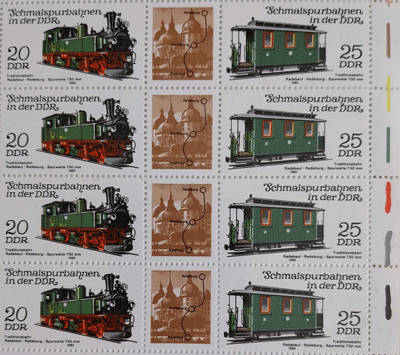
Alan King,
with Paul Barry, Editor
********************************************
Meeting held on 22nd May 2023
"Labuan" - John Higgins FRPSL
Thinking back to school days, and those very simplified printed stamp albums, I have firmly fixed in my memory that the page titled ‘Labuan’, was always bereft of stamps. We just did not see any issues. So, when I saw Club was to have a major presentation on this country, I was hard pressed to find much enthusiasm! Except, that is, for two facts, one being the Club’s Programme Secretary -Hugh Jefferies, who always sources superb displays, the second being the Speaker, Dr Jon Higgins FRPSL.
What a treat there was in store! First, it was essential to get pronunciation correct! Was it ‘Labu-anne’ or ‘Laboon’? No, said Jon, - ‘La-boo-an’ is correct’. We moved on to maps and location, revealing Labuan to be an island off the coast of North Borneo. It was ceded to Britain by the Sultan of Brunei in 1846. Jon provided further geographical and historical background, stating: ‘Labuan is a small island, about a third of the size of the Isle of Wight. Prior to it becoming a Colony, it had no permanent population due to the activities of pirates, but after 1846 it was gradually settled by Chinese or Kedayan farmers and traders. Until the advent of Malaysia in 1963 there was only one post office in the capital, Victoria. Labuan became important during conflicts, notably during the 1945 Japanese presence, and the Indonesia confrontation in the 1960s. It is now a thriving free port with a population of 90,000 plus’. (Courtesy of Jon Higgins and ‘Stamp Lover’ publication, and again below)
Jon most ably traced the philatelic history, commencing with the island joining the U.P.U. and in 1877 stamps were required. The design featured the head of Queen Victoria, based on the ‘Young head’ Wyon medal minted to mark the Royal visit to City. Taking pride of place in this magnificent display was Jon’s own cased silver Wyon Medal!! ...I held it in my hand for at least 10 seconds! (one of 120 minted; the one gold medal being presented to Queen Victoria!!) The first philatelic item displayed was a die proof of the 12c value, the only die proof recorded of any of the Queen’s Head stamps of Labuan. To qoute: ‘I never expected to own it, it was part of an SG investment portfolio which was sold to venture capitalists who then sold it on through an obscure Channel Islands auction house, and only paid reserve...’. This issue of 1879 was the first recess stamps printed by D.L.R., but there was much more to follow.
The overall display was of high quality indeed and focussed greatly on plate proofs, production process, engravings and Specimen stamps, all relating to the May 1879 issue. It then progressed on to later issues. It had huge range, incorporating drawings, stamps, including sheets, postal stationery, covers, watermark varieties, over-printings, temporary cancels, postal rates, printers' and details of the island’s administration over time.
The presentation was superbly composed and written-up. For those philatelists wishing to delve deeper into this fascinating collection, there is a magnificent Labuan report resource to consider, being that in the publication ‘Stamp Lover’ Vol. 115 June 2023. (with grateful acknowledgements to Jon and the Editor) Mentioned here, there are also Jon’s excellent Zoom presentations to NPS to further develop the subject.
Chairman, Rod Greer gave a most enthusiastic vote of thanks, and presented Jon with an engraved glass whisky tumbler, a memento of the Club’s appreciation of a truly great evening!
-3--w.gif) |
-300w.gif) |
-300w.gif)
-200w.gif) |
-300w.gif) |
Paul Barry Publicity Officer
************************************************************************
|
-300w.jpg)
-150w.jpg)
-139w.jpg)
-200w.jpg)
-249w.jpg)
-235w.jpg)
-190w.jpg)
-212w.jpg)

-225w.jpg)
-282w.jpg)
275w.jpg)
-225w.jpg)
-225w.jpg)
-225w.jpg)
141h.jpg)
225w.jpg)
-187h.jpg)
-187h.jpg)














-11Aug2025-350w.jpg)
-11Aug2025-332w.jpg)
-11Aug2025-450w.jpg)

28Jul2025-250w.jpg)
-28Jul2025-250w.jpg)
-28Jul2025-250w.jpg)
-25Jul2025-457w.jpg)
-25Jul2025-250w.jpg)
-25Jul2025-250w.jpg)
-25Jul2025-254w.jpg)
-25Jul2025-251w.jpg)

-250w.jpg)
-250w.jpg)
-225w.jpg)
-330w.jpg)
-307w.jpg)
-340w.jpg)
-310w.jpg)

-600w.jpg)
-317w.jpg)
-250w.jpg)
-350w.jpg)
-350w.jpg)
-336w.jpg)

-301w.jpg)
-253w.jpg)
-247w.jpg)
-300w.jpg)

-300w - Copy.jpg)
-260w.jpg)
-300w.jpg)
-315w.jpg)
-250w.jpg)
-190w.jpg)
-216w.jpg)

-135w.jpg)
-138w.jpg)
-131w.jpg)
-122w.jpg)
-250w.jpg)
-250w.jpg)
-180w.jpg)
-250w.jpg)
-249w.jpg)
-250w.jpg)
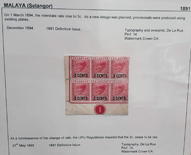
-234w.jpg)
-200w.jpg)

-359w.jpg)
-350h.jpg)
-350w.jpg)
380h.jpg)


-250w.jpg)
-261w.jpg)
-283w.jpg)
-250w.jpg)
-362w.jpg)
-300w.jpg)
-250w.jpg)

-400w.jpg)
.jpg)
-400w.jpg)

-350w.jpg)
-350w.jpg)
-370w.jpg)
-350w.jpg)
-350w.jpg)
-419w.jpg)


-25Nov2024-220w.jpg)
-25Nov2024-227w.jpg)
-25Nov2024-234w.jpg)
-25Nov2024-225w.jpg)
-25Nov2024-215w.jpg)
-25Nov2024-224w.jpg)
-25Nov2024-225w.jpg)
-25Nov2024-231w.jpg)
-25Nov2024-248w.jpg)
-200h.jpg)

-11-Nov24-600w.jpg)
-11Nov24(6)-450h.jpg)
-11Nov24-450h.jpg)
-11Nov24-450h.jpg)
-11Nov24-450h.jpg)
-11Nov24-450h.jpg)

-350w.jpg)
-367w.jpg)
-550w.jpg)
-600w.jpg)
-277w.jpg)
-257w.jpg)
-315w.jpg)

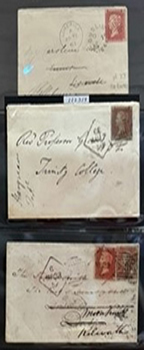
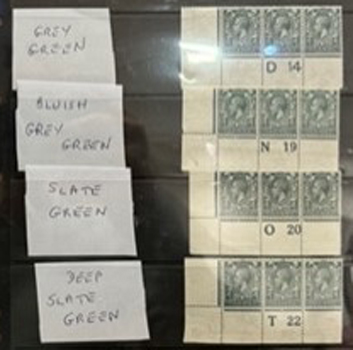

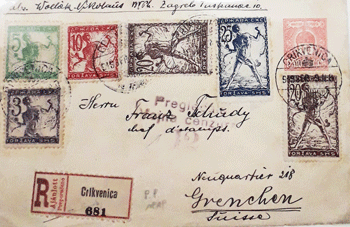
-403w.jpg)
-250w.jpg)
-250w.jpg)
-250w.jpg)
-221w.jpg)
-510w.jpg)
-500w.jpg)
-600w.jpg)
-350w.jpg)
-315w.jpg)
-250w.jpg)
-367w.jpg)
-350w.jpg)
-350w.jpg)
.jpg)
-300w.jpg)
-350w.jpg)
-350w.jpg)
-400w.jpg)
-650w.jpg)
-650w.jpg)
-650w.jpg)
-650w.jpg)
-650w.jpg)
-650w.jpg)
-650w.jpg)
-250w.jpg)
-250w.jpg)
-250w.jpg)
-350w.jpg)
-367w.jpg)
-348w.jpg)
-350w.jpg)
-27May2024-250w.jpg)
-27May2024-253w.jpg)
-27May2024-248w.jpg)
-27May2024-250w.jpg)
-27May2024-245w.jpg)
-27May2024-300w.jpg)
-27May2024-300w.jpg)
22April2024-650w.jpg)

-Text-725w.jpg)
-350w.jpg)
-350w.jpg)
-350w.jpg)
-350w.jpg)






-350w.jpg)
-350w.jpg)
-465w.jpg)
.jpg)
-500w.jpg)
-500w.jpg)
.jpg)
-475w.jpg)
-450w.jpg)


-291h.jpg)
-117h.jpg)
-280h.jpg)
-115h.jpg)
-116h.jpg)
-297h.jpg)
-188h.jpg)
-121h.jpg)
-290h.jpg)
-202h.jpg)
-119h.jpg)
-308h.jpg)

-250w.jpg)
-250w.jpg)
-250w.jpg)
-250w.jpg)
-500w.jpg)
-350w.jpg)
-350w.jpg)
-210w.jpg)
-350w.jpg)
-350w.jpg)
-700w.jpg)
-250w.jpg)
-250w.jpg)
-250w.jpg)
-250w.jpg)
-250w.jpg)
-250w.jpg)
-250w.jpg)
-250w.jpg)
-250w.jpg)
-250w.jpg)
-250w.jpg)
-300w.jpg)
x300w.jpg)
-300w.jpg)
-300.jpg)
-360w.jpg)
-281w.jpg)
-250w.jpg)
-250w.jpg)
-250w.jpg)
-350w.jpg)
-364w.jpg)
-400w.jpg)
-350w.jpg)
-350w.jpg)
-350w.jpg)
-306w.jpg)
-450w.jpg)
-250w.jpg)
-250w.jpg)
-149.jpg)
-300w.jpg)
-327w.jpg)
-250w.jpg)
-243w.jpg)
-248w.jpg)
-450w.jpg)
-250w.jpg)
-250w.jpg)
-250w.jpg)
-600w.jpg)
-223w.jpg)
-239w.jpg)
-300w.jpg)
-368w.jpg)

-3--w.gif)
-300w.gif)
-300w.gif)
-200w.gif)
-300w.gif)